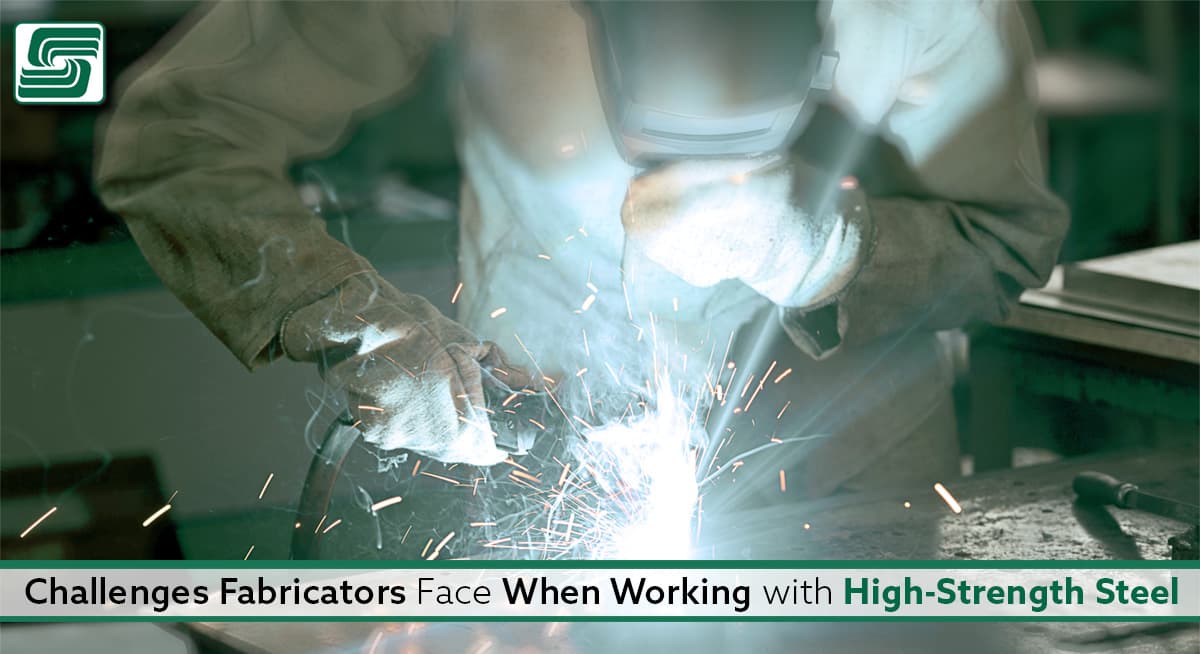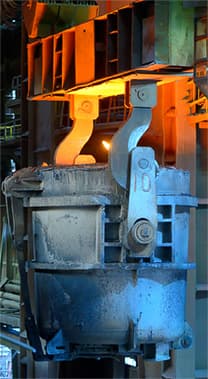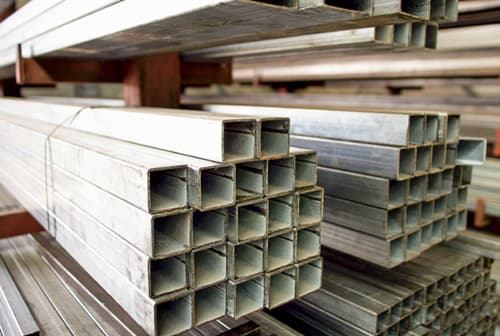
Steel is a crucial component of engineering and manufacturing, with many properties and applications. One of the most popular forms of steel used in the industry is high-strength steel—favored for its high strength-to-weight ratio.
Despite its many benefits, high-strength steel poses several challenges for metal fabricators. This article explores the different types of high-strength steel, the properties and challenges of working with this type of metal, and the techniques and tools used by metal fabricators to work with it safely.
Types of High-Strength Steel
There are three broad-group categories for high-strength steel—based on its properties and fabrication ability.
- Ultra-high-strength (UHS)
- Extremely high-strength (EHS)
- High-strength steel (HSS)
| Group |
Minimum Yield Strength (MPa) |
| Ultra-high-strength (UHS) |
3,000 |
| Extremely high-strength (EHS) |
1,000 |
| High-strength steel |
750 |
High-Strength Steel Properties
 High-strength steel has a higher yield strength than other types of steel, making it more suitable for applications requiring excessive structural strength and stiffness, such as bridges, tall buildings, and wide bridges.
High-strength steel has a higher yield strength than other types of steel, making it more suitable for applications requiring excessive structural strength and stiffness, such as bridges, tall buildings, and wide bridges.
Certain types of machinery use high-strength steel, such as drills and saws, where a great deal of rigidity is required, as well as in construction, where it builds the foundations of buildings and large infrastructure projects. High-strength steel's increased wear resistance is the primary reason for its use in these applications.
However, because high-strength steel doesn't have the strength of ultra-high-strength steel, it can't be used in applications requiring high strength and durability, such as automobiles and military equipment.
Challenges
Ultra-high-strength steel (UHSS) is a highly challenging material for metal fabricators to work with. There are several difficulties that metal fabricators face when working with this type of steel, which can affect the final product's mechanical properties and quality.
One difficulty is the limitations of traditional fabrication methods. Traditional methods cannot process most high-strength steel, which makes it necessary for metal fabricators to develop new processes for machining high-strength steel or adding secondary operations to reduce the risk of breakage during primary operations.
Another challenge metal fabricators face when working with UHSS is the spatiotemporal phase transformation during the hot stamping process. This phase transformation significantly affects the microstructure and mechanical properties of the steel, making it necessary to tailor the mechanical properties of UHSS components during the manufacturing process.
Welding UHSS is also a significant challenge, as the difficulties faced in welding this type of steel differ from the challenges in welding other steel grades like High Strength Low Alloy steel (HSLA). They can alter the microstructure and mechanical properties of UHSS because a higher percentage of carbon may reach 0.3%, making it difficult to achieve a high-quality weld.
In conclusion, working with UHSS is a highly challenging task for metal fabricators, as it requires the development of new fabrication methods, careful consideration of the hot stamping process, and expertise in welding to produce components with the desired mechanical properties. Metal fabricators must consider these challenges to produce high-quality components made of UHSS.
Techniques and Tools for Working with High-Strength Steel
 Machining: High-strength steel usually can't be machined like other types of steel. However, low-alloy steels can be machined to make internal components, as they are generally too hard to machine by themselves.
Machining: High-strength steel usually can't be machined like other types of steel. However, low-alloy steels can be machined to make internal components, as they are generally too hard to machine by themselves. - Welding: Welding high-strength steel can be challenging for several reasons. High levels of carbon in these steels can produce sparks that ignite clothing and equipment, so employees must wear welding gloves and protective gear.
- Cutting: High-strength steel often has high levels of carbon, making them difficult to cut. High-carbon steels are also harder to work with than low-alloy steels, so sharpening tools can be more difficult to maintain.
- Honing: Metal fabricators hone high-strength swords and other cutting tools to maintain their sharp edges and prevent dullness. However, honing these steels can be time-consuming because of their high carbon content. To simplify the honing process and keep the cutting edge sharp, the fabricators use a honing tool that reduces the carbon content in the tool.
Tips and Best Practices for Working with High-Strength Steel
Before fabricating high-strength steels, metal fabricators should be sure that all of their tools and equipment are safe to use on these materials.
- High-strength steels are harder to machine than other types of steel and require lower speeds and spindle speeds to reduce the risk of damage.
- When welding high-strength steel, metal fabricators use different techniques, such as gas shielding or shielded gas welding, to protect it from damage.
- Metal fabricators can use a slower cutting speed when cutting high-strength steel than other types of steel.
- Tools and equipment used to safely work with low-alloy steels can damage or even destroy high-strength steels, so metal fabricators should adjust their techniques or even use different tools and techniques.
In Sum
Working with high-strength steel requires great expertise, skill, and attention to detail. Metal fabricators must understand the unique challenges of working with this type of metal, from its high-carbon content to the difficulties faced in welding and cutting.
The tools used by metal fabricators to work with high-strength steel require careful selection and correct usage to avoid damage and produce high-quality components.
With the right techniques and tools, metal fabricators can produce high-quality components from high-strength steel, which is essential for building robust and durable infrastructure projects.